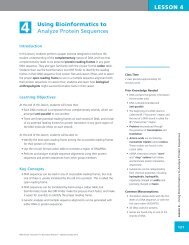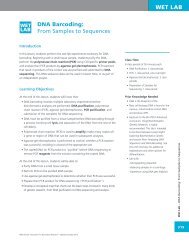LESSON 1: - Northwest Association for Biomedical Research
LESSON 1: - Northwest Association for Biomedical Research
LESSON 1: - Northwest Association for Biomedical Research
You also want an ePaper? Increase the reach of your titles
YUMPU automatically turns print PDFs into web optimized ePapers that Google loves.
STUDENT HANDOUT 1.1cThe Tuskegee Syphilis StudyCase Study C: The Tuskegee Syphilis Study(Formally known as the U.S. Public Health Service Tuskegee Study of Untreated Syphilis)From 1932 to 1972, the U.S. government conducted a study that focused on understanding the long-term effects ofuntreated syphilis, a sexually transmitted disease caused by bacteria. The original intent of the study was to show that thedisease was “potentially…the same in African Americans and Caucasians.” The government claimed it wanted to studythe effects of the disease so that it could develop programs to help treat syphilis in the local community.The Tuskegee Syphilis Study, named after a college <strong>for</strong> black people called the Tuskegee Institute, took place in MaconCounty, Alabama. The study involved the active recruitment of poor, black, male sharecroppers. The researchersconducting the study told the men that they would be treated <strong>for</strong> “bad blood,” a term that was used in the localcommunity to describe the symptoms of syphilitic disease—fatigue, fever, sores, and muscle aches.The study, which was supposed to last up to nine months, continued <strong>for</strong> more than 40 years. Initially the study wasapproved by the Alabama state government with the expectation that the men would be treated <strong>for</strong> the disease.<strong>Research</strong>ers treated the men with the standard use of mercury and bismuth. These highly toxic remedies weresometimes fatal, and were only slightly effective since the cure rate was less than 30 percent and the treatmentlasted several months.Of the 600 men who enrolled and who consented, 399 men had syphilis and 201 did not have the disease. Although themen gave their consent, they were never in<strong>for</strong>med about the research itself or that some of them actually had syphilis. Inexchange <strong>for</strong> their cooperation, the men were promised free medical care, free meals, free travel to and from the clinics,and insurance <strong>for</strong> burials so that their families would not need to worry about the cost of their deaths.In 1947, penicillin became available and was widely distributed as a highly effective treatment <strong>for</strong> syphilis; it became thestandard of medical care <strong>for</strong> this disease. Although the researchers were aware that penicillin was effective against syphilis,they wanted to observe the consequences of the disease over time. The infected men in the study were never made awareof nor offered penicillin treatment.In 1972, the study ended when a reporter wrote about the research in The New York Times. An advisory committee was<strong>for</strong>med to look into the study and strongly advised the researchers to stop the study. The men and their families received$10 million in a settlement, and received healthcare <strong>for</strong> their wives and children. More than 100 men in the study diedfrom syphilis-related complications, and some of the patients’ wives and children also contracted syphilis, which issexually transmitted and can be passed to the fetus during pregnancy. The patients and their families did not receive a<strong>for</strong>mal public apology from the U.S. government until President Bill Clinton apologized in 1997.This summary is based on a true story. Please see the Sources section <strong>for</strong> reference in<strong>for</strong>mation.Contributed by Myra Arnone, Redmond High School, Redmond, WA.HANDOUTPenicillin: An antibiotic drug made from penicillium mold (or produced synthetically) used to treat infectionsand diseases.Syphilis: A sexually transmitted disease caused by bacteria, which can cause skin lesions. Left untreated,syphilis can cause inflammation, meningitis, and other central nervous system damage, as well ascardiovascular damage. Syphilis can remain in the body undetected <strong>for</strong> many years (latency) andsymptoms can appear more than 40 years later.© <strong>Northwest</strong> <strong>Association</strong> <strong>for</strong> <strong>Biomedical</strong> <strong>Research</strong>HUMANS IN RESEARCH |25
















